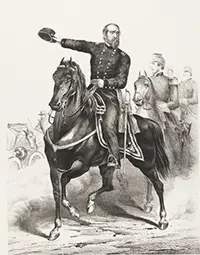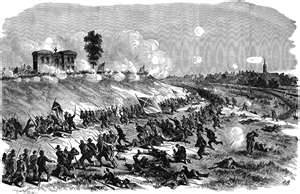Union General George Gordon Meade
George Gordon Meade was a Union general during the American Civil War. He served for most of the war and is most well-known for being the victorious commander at the pivotal Battle of Gettysburg. 
He was born on Dec. 31, 1815 in Cádiz, Spain. He grew up in Philadelphia and also lived in Baltimore and Washington, D.C. He attended Mount Hope Institution in Baltimore and the American Classical and Military Lyceum in Philadelphia. He enrolled in the U.S. Military Academy in 1831 and graduated four years later. Meade fought in the Second Seminole War in Florida and in the Mexican-American War, earning acclaim for his efforts at the Battle of Monterrey. After that war, he served in the Army Corps of Topographical Engineers along the Atlantic coast and conducted surveys of the Great Lakes area. In 1840, he married Margaretta Sergeant, the daughter-in-law of Henry Clay; the couple had seven children. 
Meade gained his first command as head of a Pennsylvania brigade in 1861, and he and those men first fought at Gaines's Mill, in June 1862. Later that month, Meade sustained serious injured in the arm, back, and side at the Battle of Glendale, during the Battle of the 7 Days. That didn't stop him from leading his men in the Second Battle of Bull Run. He went on to command troops in the Union victories against Robert E. Lee's Army of Northern Virginia at South Mountain and Antietam. In the disastrous assault on the heavily fortified Confederate forces at Fredericksburg, Meade was one whose men could claim some form of success, in that they were the only group of Union soldiers who managed to break through the Confederate line. Meade performed with distinction during an otherwise ineffectual Battle of Chancellorsville and, on June 28, 1863, found himself named commander of the Army of the Potomac. 
Just a week later, Meade had demonstrated considerable ability in directing his army's victory at the historic Battle of Gettysburg, seizing the high ground, moving troops around the battlefield as needed, and imploring his men to withstand several furious charges by the inspired Confederates. Like a few of his predecessors, Meade refused to pursue Lee's army as it retreated from Gettysburg. For the next several months, Union and Confederate troops engaged in minor skirmishes but no major battles. In meeting with the Union's new top commander, Ulysses S. Grant, in early 1864, Meade offered to resign as head of the Army of the Potomac. Grant refused to accept that resignation but did nominally take charge of the army's movements all the same. Meade remained in charge of the Army of the Potomac for the remainder of the war, commanding its men in battle after battle that gradually wore down the Confederate defenses. Meade remained in the Army after the end of the war, commanding the Military Division of the Atlantic. In 1866, he became commissioner of Philadelphia's Fairmount Park. He later served as governor of the Reconstruction Third Military District. He died of pneumonia on Nov. 6. 1872. |
|
Social Studies for Kids
copyright 2002–2024
David White




